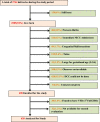Hemodynamic parameters after Delayed Cord Clamping (DCC) in term neonates: a prospective observational study
- PMID: 35524194
- PMCID: PMC9074198
- DOI: 10.1186/s12887-022-03303-4
Hemodynamic parameters after Delayed Cord Clamping (DCC) in term neonates: a prospective observational study
Abstract
Background: Delayed cord clamping (DCC) is practiced worldwide, as standard care in both term and preterm babies. Our aim was to determine the hemodynamic effects of DCC on transitional circulation.
Material and methods: This prospective observational study was carried out in a tertiary care hospital, at Pune, India, from May 2018 to October 2019.Term neonates born during the study period were included. The primary outcome variables of the study were right ventricular output (RVO), left ventricular output (LVO), superior vena cava (SVC) flow (ml/kg/min) and heart rate(HR) at 12 ± 6 and 48 ± 6 h of life measured by point of care functional echocardiography. Inter-observer and intra-observer variability was calculated for these parameters.
Results: Out of a total of 2744 deliveries during the study period, 620 babies were included. Mean gestational age of the enrolled babies was 38.96 ± 1.08 weeks and mean birth weight was 2.9 ± 0.39 kg. Mean heart rate of babies recorded at 12 ± 6 h of life was 127 beats per minute (bpm) whereas it was 128 bpm at 48 ± 6 h of life. RVO {mean (SD)} was 209.55(44.89) and 205.85(46.35) ml/kg/min, LVO {mean (SD)} was 133.68(31.15) and 134.78(29.84) ml/kg/min whereas SVC flow {mean (SD)} was 106.85(26.21) and 109.29(25.11) ml/kg/min at 12 ± 6 and 48 ± 6 h of life respectively. There was good intra-observer agreement in all the variables. SGA babies had a significantly higher heart rate at 12 ± 6 h of life as compared to AGA babies, although this difference in heart rate could not be appreciated at 48 ± 6 h of life. However SGA babies had a higher LVO, RVO and SVC flow than AGA babies at both the time points of observation.
Conclusion: After DCC there is less fluctuation in the hemodynamic parameters (heart rate, cardiac output) at the two time points of observation.. As compared to AGA babies, SGA babies had a significantly higher baseline heart rate, LVO, RVO and SVC flow. LVO of SGA babies after delayed cord clamping is found to be significantly lower than LVO seen in other studies, favoring the cardio-stabilizing effect of DCC.
Brief rationale: This is the first study with a large sample size evaluating the hemodynamic effects of DCC in term neonates by functional echocardiography. The normative data of heart rate and cardiac output of term, stable babies with small for gestational age(SGA) as a special subgroup undergoing DCC requires further evaluation.
Keywords: Delayed cord clamping (DCC); Functional echocardiography (FnEcho); Transitional circulation.
© 2022. The Author(s).
Conflict of interest statement
The authors declare that they have no competing interests.
Figures




Similar articles
-
Effects of delayed cord clamping in intrauterine growth-restricted neonates: a randomized controlled trial.Eur J Pediatr. 2021 Jun;180(6):1701-1710. doi: 10.1007/s00431-021-03959-7. Epub 2021 Jan 21. Eur J Pediatr. 2021. PMID: 33479800 Clinical Trial.
-
Cardiac blood flow measurements in stable full term small for gestational age neonates.J Clin Diagn Res. 2013 Aug;7(8):1651-4. doi: 10.7860/JCDR/2013/5671.3302. Epub 2013 Aug 1. J Clin Diagn Res. 2013. PMID: 24086865 Free PMC article.
-
Hemodynamic Changes with Umbilical Cord Milking in Nonvigorous Newborns: A Randomized Cluster Cross-over Trial.J Pediatr. 2023 Jun;257:113383. doi: 10.1016/j.jpeds.2023.03.001. Epub 2023 Mar 11. J Pediatr. 2023. PMID: 36914049 Free PMC article. Clinical Trial.
-
The effect of delayed cord clamping on early cardiac and cerebral hemodynamics, mortality, and severe intraventricular hemorrhage in preterm infants < 32 weeks: a systematic review and meta-analysis of clinical trials.Eur J Pediatr. 2025 Feb 26;184(3):210. doi: 10.1007/s00431-025-06026-7. Eur J Pediatr. 2025. PMID: 40009183
-
Delayed umbilical cord clamping for reducing anaemia in low birthweight infants: implications for developing countries.Ann Trop Paediatr. 2006 Sep;26(3):157-67. doi: 10.1179/146532806X120246. Ann Trop Paediatr. 2006. PMID: 16925952 Review.
Cited by
-
Assessment of systemic circulation using ultrasound Doppler in late onset neonatal sepsis and its clinical correlation: an observational study.J Ultrasound. 2023 Dec;26(4):851-859. doi: 10.1007/s40477-023-00826-z. Epub 2023 Sep 20. J Ultrasound. 2023. PMID: 37728683 Free PMC article.
References
-
- Mercer JS. Current best evidence: a review of the literature on umbilical cord clamping. In: Wickham S, editor. Midwifery: best practice. Vol. 4. Edinburgh: Elsevier; 2006. pp. 114–29. - PubMed
Publication types
MeSH terms
LinkOut - more resources
Full Text Sources
Medical
Research Materials
Miscellaneous

